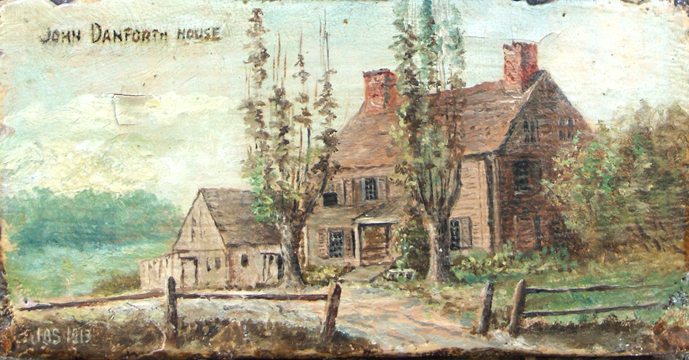Dorchester Illustration no. 2457 John Danforth/Maria Cummins House
The Dorchester Historical Society has a collection of bricks collected by Edward Huebener at the end of the 19th century. Huebener was a board member of the Society. The bricks have portraits of Dorchester buildings, and the story is that each brick came from the building whose portrait is carries.
The Rev. John Danforth House, built in 1712, was located on Bowdoin Street at the site now occupied by the St. Peter’s parochial school building.
John Danforth, 1660-1730
The Rev. John Danforth graduated from Harvard College in 1677 and was ordained as minister of the First Church in Dorchester in 1681. He served 48 years, the longest tenure in the history of the Church, but Orcutt says “in all this time nothing of consequence occurred.” In 1712 he gave up his right to live in the ministry house, and he built the house on Bowdoin Street, and lived there until his death in 1730. Dr. Thaddeus Mason Harris, in his Chronological and Typographical Account of Dorchester, mentioned that Danforth was something of a poet. During his ministry, in 1698, the Young Men’s Union was formed in Dorchester, a society for religious purposes which continued in existence until 1848, a period of one hundred and fifty years.
In 1732 the house was converted to use as the Turk’s Head Tavern. Stage coaches from Boston and Roxbury stopped here. The coaches would stop again at Robinson’s Tavern on Washington Street before continuing on along to the bridge at Lower Mills and on toward Plymouth.
In the 19th century the building was again a private home, and Judge Cummins, judge in the court of common pleas in Norfolk County, and his daughter Maria Cummins lived here.
Maria Cummins, 1827-1866
Born in Salem in 1827 to a family of some social standing and relative affluence, Maria Susanna Cummins moved, while still quite young, with her family to Dorchester, at that time still a rural suburb separate from Boston. Maria’s father, David, had become a judge of the court of common pleas of Norfolk County. Her mother was David’s third wife. He already had four children prior to this marriage, and three more followed Maria, making eight children in the family. Families of stepbrothers and sisters were common, so the characters of stepmother or father, orphan, etc., of the fiction of the day were not unrelated to the reality of the times. The Cummins Colonial home may have been the model for the country seat in the suburb of D—— in The Lamplighter. Maria attended Mrs. Charles Sedgwick’s Young Ladies’ School in Lenox, Massachusetts. Mrs. Sedgwick’s husband, Charles, had a sister Catharine Maria Sedgwick, who was the nation’s foremost woman author and who lived with her brother and maintained an occasional literary salon. Maria could not have failed to be influenced by her association with this author.
Maria Cummins’s The Lamplighter, first published in 1854, sold 40,000 copies in the first month and 100,000 by the end of a year. It is the story, as described in the Dictionary of American Biography, of a child lost in infancy, rescued from a cruel woman by an old lamplighter, adopted by a blind woman, and later discovered by her well-to-do father. It tells a woman’s story: a young girl, without financial resources or family support, must find her own way. The plot focuses on the development and use of the main character’s own talents, and he book is intended in this manner to be useful and instructive. Readers should examine their own circumstances and should develop self-control and self-discipline. The characters in the book are mainly people from the country who have come to Boston from small towns and farms of New England, a trend reflective of society at the time. Nina Baym says “Rural women … Could not merely replicate the behavior of the uplands they had left behind. To be a woman in a new social setting was, in effect, to be a new kind of woman.”
The Lamplighter is the book to which Hawthorne specifically referred in his famous complaint that “America is now wholly given over to a d____d mob of scribbling women. The Lamplighter was published when Maria was twenty-seven years old. She became seriously ill ten years later and died in 1866 of abdominal disease. She was able to write a total of only four books: The Lamplighter (1854), Mabel Vaughan (1857), El Fureidis (1860) and Haunted Hearts (1864). None of the other three achieved great success.

